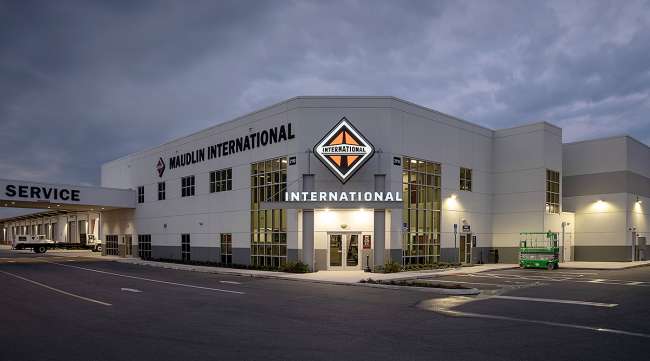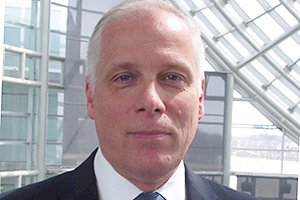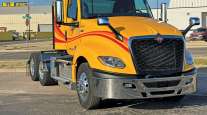Senior Reporter
Navistar Unveils Strategic Plan to Increase Market Share

[Stay on top of transportation news: Get TTNews in your inbox.]
BOULDER, Colo. — Navistar International unveiled a strategic plan Aug. 6 that company leaders said will help it expand its market share, sharpen its focus on customers and reduce the time it takes to repair trucks through a strengthening of its existing dealer network.
“We are at a point where we have revamped our entire product portfolio, which I always consider the point to be competitive in the marketplace — and we are competitive,” said Friedrich Baumann, president for aftersales and alliance management, during a meeting with reporters here. “Now we need to create the right services with this product, and it’s all about growth and regrowth of our business. We have to change our mindset to make the long view to get us to where we want to be in three to five years from now.”
Navistar officials and dealers shared with reporters the company’s Vision 2025 strategic plan, planned technology upgrades and service expansion they say will drive growth the next five years.

Baumann via LinkedIn
The company also has set a goal to improve its customer service ranking from an industry-bottom fourth place.
Baumann pointed to two recent moves the company has made to help it achieve that goal: On Aug. 26, Navistar will open a 300,000-square-foot parts distribution center near FedEx’s World Hub in Memphis, Tenn., allowing for parts delivery anywhere in the country, often in less than 12 hours.
On Aug. 1, the company launched a service network with Love’s Travel Stops & Country Stores and Speedco that will provide warranty and other repairs to 500 service bays nationwide and access to an additional 1,300 technicians.
Keeping trucks on the road and improving uptime is a critical component of Vision 2025.
The company provided data that showed, industrywide, just 45% of trucks that are in for service are back on the road within 24 hours. Navistar said its goal is to be above 80%.
Baumann stressed shortening the turnaround time for repairs to less than 24 hours will improve customer loyalty by increasing the time the truck is on the road, lowering the cost of ownership and making those vehicles more profitable.
Navistar’s warranty performance and service partnership agreement with @LovesTravelStop and @SpeedcoPM is now fully operational, activating the commercial vehicle industry’s largest service network in North America. https://t.co/69dIMxYILY pic.twitter.com/nAjdtn5gU0 — Navistar Newsroom (@NavistarNews) August 1, 2019
Navistar said from the first quarter of 2018 through its fiscal third quarter, which ended June 30, the number of trucks repaired and back on the road within 24 hours of entering a service center improved by 73%. The company noted that predictive analytics would help by determining when a truck needs to visit the shop, reducing the amount of time it takes to get the required parts and complete repairs. Navistar said its On Command Connection telematics service uses an open software platform, and 380,000 trucks on the road are being monitored for service and potential repair issues.
“These are changes that are starting to take place now. But I am absolutely convinced what will make our company great going forward is being way more centered around the customer and listening and understanding what their needs are and then delivering on those requirements,” Baumann added. “We need to work closely in a close, respectful and trusted relationship with our dealers. Because, in the end, our dealers are the ones that are really delivering the service to our customer.”

In our third episode of RoadSigns, Season Three, we ask: Is Predictive Maintenance the Next Big Leap for Fleet Efficiency? Hear a snippet from host Seth Clevenger, above, and get the full program by going to RoadSigns.TTNews.com.
Baumann also noted that Navistar is on track to increase its new-truck market share by the end of its fiscal year in October to more than 18%, and is pushing to increase that share to at least 25% by 2025.
Navistar’s new direction comes as the company is working to rebuild trust with its customers and put behind it the controversy when in the mid-2000s it elected to use exhaust gas recirculation (EGR) technology to reduce nitrogen oxide emissions from its heavy-duty trucks. Those vehicles were equipped with MaxxForce 11- and 13-liter engines. After spending $700 million to develop the EGR technology, it failed to meet federal emissions standards. The company paid more than $1 billion to cover warranty costs related to fuel-economy and reliability issues and an additional $500 million to buy back used trucks from dissatisfied customers. This past May, Navistar also earmarked about $160 million to settle a class-action lawsuit related to the failed technology.
As the MaxxForce engine controversy lingered, and costs skyrocketed, Navistar saw its market share plunge by almost 50%, putting it in fourth place in the industry.
“I wouldn’t call it a turnaround plan, I would rather call it a growth plan,” Baumann said. “I have heard personally from some of these customers they’re regaining trust to our products, our capabilities, as a partner into our brand, and we have turned some of these customers, who had turned away from us, into raving fans for what we are doing today.”




